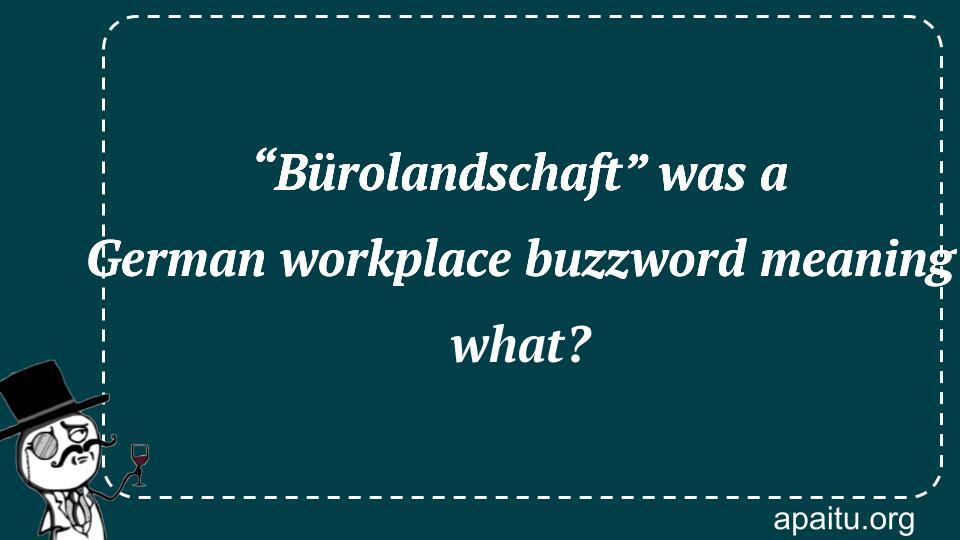Question
Here is the question : “BüROLANDSCHAFT” WAS A GERMAN WORKPLACE BUZZWORD MEANING WHAT?
Option
Here is the option for the question :
- Technological revolution
- Fair wages for all
- Working for the man
- Office landscape
The Answer:
And, the answer for the the question is :
Explanation:
Eberhard and Wolfgang Schnelle, brothers, created the idea of Bürolandschaft in the 1950s. It was both an architectural trend and a post-World War II social movement in favor of cutting-edge office architecture. In Bürolandschaft, desks are loosely divided by plants and curved screens in an open, participatory workspace. It soon reached the United States and is still prevalent in many contemporary offices today.

In the realm of workplace design, certain buzzwords emerge that capture the essence of a particular concept or philosophy. One such term that gained prominence in the mid-20th century is “Bürolandschaft,” a German word meaning “office landscape.” Bürolandschaft represents a revolutionary approach to office design that aimed to create more open, flexible, and collaborative work environments. In this article, we will delve into the meaning and significance of Bürolandschaft and its impact on the modern workplace.
The Bürolandschaft concept emerged in the 1950s as a response to the rigid and hierarchical office layouts prevalent at the time. It was a brainchild of two German designers, Eberhard and Wolfgang Schnelle, who sought to reimagine the traditional office space to promote communication, creativity, and employee well-being. Bürolandschaft challenged the conventional cubicle-based model by introducing a more organic and dynamic office layout.
At the heart of Bürolandschaft was the idea of creating an office environment that mimicked the natural landscape. Instead of fixed walls and partitions, the office was transformed into a fluid and interconnected space. The office layout incorporated elements such as rolling screens, low partitions, and varying levels of work surfaces to create visual openness and encourage communication among employees. The arrangement of furniture and workstations was designed to resemble clusters or islands, fostering a sense of community and collaboration.
One of the key principles of Bürolandschaft was the concept of “communication zones.” These zones were strategically placed within the office layout to encourage spontaneous interactions and exchanges of ideas. By removing physical barriers and promoting face-to-face communication, Bürolandschaft aimed to enhance teamwork, problem-solving, and innovation. The emphasis on social interaction and the free flow of information was a departure from the isolated and compartmentalized nature of traditional office designs.
Bürolandschaft also recognized the importance of employee well-being in the workplace. The concept introduced elements of nature, such as plants and natural lighting, to create a more pleasant and inviting atmosphere. By incorporating greenery and maximizing access to natural light, Bürolandschaft sought to improve employee morale, productivity, and overall satisfaction.
The Bürolandschaft movement gained significant traction in Europe and influenced office design around the world. Its principles resonated with businesses looking to foster a more collaborative and dynamic work environment. The concept was particularly embraced by creative industries and knowledge-based organizations that valued teamwork, innovation, and flexibility.
However, Bürolandschaft was not without its challenges and criticisms. As the concept gained popularity, some companies misinterpreted it as a mere trend, resulting in poorly implemented open office spaces that lacked proper planning and consideration for individual needs. Noise distractions, privacy concerns, and a lack of personal space became common issues associated with Bürolandschaft-inspired designs. These challenges highlighted the importance of striking a balance between open collaboration and the need for focused work and privacy.
Over time, the Bürolandschaft concept has evolved and adapted to address these concerns. Today, modern office designs often incorporate a hybrid approach, combining open collaborative spaces with private areas and quiet zones. Flexibility, choice, and individual well-being have become key considerations in office design, ensuring that employees have the freedom to choose the working environment that suits their tasks and preferences.
Bürolandschaft, meaning “office landscape,” represents a significant shift in office design philosophy. It challenged the traditional notions of compartmentalized workspaces and advocated for open, collaborative environments that fostered communication and creativity. While the concept faced criticisms and required refinement, its influence on modern office design is undeniable. Bürolandschaft sparked a global conversation about the importance of flexible and people-centric workplaces, leading to the development of diverse and adaptable office environments that support employee well-being, collaboration, and productivity.